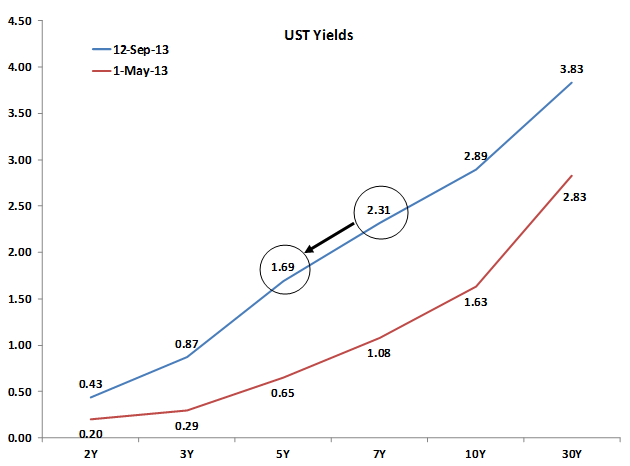Why It Might Not Be Crazy to Buy Bonds Right Now: Understanding the Roll Down

The rapid selloff in the US Treasury market has come as a surprise to many, including such famous bond investors as Bill Gross, CFA, and Jeffrey Gundlach. As the chart below shows, 10-year yields on US Treasuries (10yr UST) are about 130 bps higher since the beginning of May.
Retail investors have been rapidly selling out of bond funds. That may look either wise or unwise with the benefit of hindsight, but one often-overlooked fact remains: New and existing bond investors now have the benefit of a much steeper yield curve.
In fact, the “roll down” portion of a bond’s return is one of the most important (and often misunderstood) aspects of a bond’s total return.
If we assume that the yield curve is upward sloping, as is currently the case, we can use a simple example to demonstrate a bond’s roll.
First, take a look at this chart. It shows five-year Treasuries with a yield of 1.69% and seven-year Treasuries with a yield of 2.31%. An investor who bought a seven-year Treasury would own a bond that yields 2.31% until its maturity.
But after two years, the bond wouldn’t be a seven-year bond. It would be a five-year bond. Because the difference in yield between the seven-year at 2.31% and five-year at 1.69% is 0.62%, the 5yr UST can rise 0.62% over two years before exceeding the investor’s yield to maturity (2.31%). Therefore, we can define a bond’s roll as the amount that interest rates can rise over a specified time period before the current yield exceeds an investor’s yield to maturity (YTM).
In other words, assuming that interest rates stay the same, this positive “roll” means that the price of the bond will go up as time passes.
Since the rate selloff, the roll has increased as the yield curve has steepened. The spread between the five- and seven-year Treasury bond was only 43 bps on 1 May versus 62 bps in our example above.
Going back to our example, let’s assume two years after purchase that the 7yr UST bond rates remain the same as today. Looking at the horizon analysis screen, we enter the current yield on the 5yr UST of 1.69 (remember, two years have elapsed and rates haven’t moved) and a horizon date two years into the future on 13 September 2015. Under “Return Analysis,” we see an annualized total return of 3.69%. So, in addition to the 2.31% annual yield, the bond has appreciated as it has “rolled down the curve.”
This yield curve is historically steep. The current spread between 2- and 10-year Treasuries of 245 bps is greater than 95% of all observations and is only moderately below the all-time high of approximately 290 bps, which occurred in early 2011.
The hypotheses for the rapid rate selloff are multifold. Some believe the economy is improving faster than the Fed is expecting, and thus the Fed will need to hike rates faster than what was being priced into the market. Other participants believe the uncertainty around tapering and the Fed chair have caused everyone to simultaneously shed long duration assets.
Higher rates are now being priced into the market significantly earlier than a few months ago, thus creating this increased roll from a steeper curve. This very simple concept of “roll” is very powerful with today’s steep curve. In a time of fear and panic in fixed-income land, attractive opportunities are beginning to open up for investors willing to take advantage and invest out along the yield curve.
If you liked this post, don’t forget to subscribe to Inside Investing via Email or RSS.





4 comments on “Why It Might Not Be Crazy to Buy Bonds Right Now: Understanding the Roll Down”